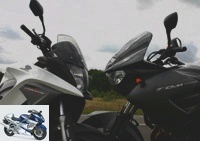Honda Crossrunner Vs Yamaha TDM 900: two five-legged motorcycles !

With the Crossrunner, Honda is revisiting in its own way a concept initiated by the Yamaha TDM in 1991: a multi-purpose motorcycle, capable of bending to everyone’s desires to satisfy everyone. Does this VFR800 born under X eclipse the indestructible TDM? ? Duel…
Two hydrids with slanted eyes
For certain motorcycle manufacturers, mainly Japanese, the ideal motorcycle would synthesize the best of each category in order to meet all needs: a sort of ideal motorcycle – or "five-legged motorcycle" – as practical in everyday life as it is effective in mountain passes. Mountain.
On paper, this multi-card hybrid concept is appealing. In practice, its development is often a puzzle and its success is not guaranteed, as everyone’s tastes and expectations differ significantly. In 1991, however, Yamaha had approached the goal with a half-trail, half-roadster machine: the astonishing 850 TDM.
Improved by small touches, the TDM now displays a six-speed gearbox, an aluminum frame, a 43 mm fork (41 mm previously), as well as braking derived from older generations of R1 and assisted by ABS since 2005. In 2002, its in-line twin increased by 48 cc to 897, while the adoption of injection and a lambda probe enabled it to meet Euro 3 standards..
20 years later, Honda in turn attempted this large gap, which is currently very popular in the automobile industry with the Crossover: designed around a VFR 800 VTEC platform, the Crossrunner is as playful as a roadster under its false airs. of trail (read our).
However, a quick glance confirms that it falls more into the category of roadsters than that of trails: in reality, its only common point with a trail is the use of a wide handlebar and placed high enough to be accessible without having to tilt the bust.
Everything else refers directly to the roadster: from the low seat (816 mm against 825 for the TDM) to the rear position of the footrests, through the low travel of the suspensions (108 mm at the front and 119 mm at the rear against 150 and 133 for the Yam ‘) and the dimensions of the tires (120/70/17 and 180/55/17 against 120/70/18 and 160/60/17 for the TDM 900).
In comparison, the Yamaha would almost make a "big grasshopper" against the compactness and the measured height of the VFR800X (the unofficial name of the Crossrunner). And the sensation continues once installed at the controls: if its narrowness at the crotch allows a pilot of 1.75 m to put his feet flat, the long tank of the TDM 900 requires to extend the arms further to grab the handlebars..
Wider than that of the Crossrunner, the TDM handlebars give the Yam ‘an upper lever arm, which facilitates low-speed maneuvers and evolutions in town. The less grown-ups will rail against the significant tension imposed on the outer arm when the steering comes to a stop..
On the other hand, the TDM saddle is much softer and the placement of its footrests more comfortable: while the large handlebars of the Crossrunner suggest an unconstrained posture, the positioning of the footrests – identical to that of a VFR800 VTEC – requires to significantly fold the legs.
Not uncomfortable for all that on medium trips, this ergonomics surprises at first glance but ends up being assimilated quickly. Especially since a good Honda, the Crossrunner gives its rider the feeling of having always known it after only a few meters. !
Its chassis as balanced as that of its "sister" VFR (normal, it’s the same within a few millimeters of wheelbase!) Immediately gives confidence, as does the subtle alliance between smoothness and precision offered by its controls: the action of the throttle on the injection is straightforward and transparent, while the clutch and brake levers (both adjustable in spacing) are operated with your fingertips.
On this point, the Yamaha suffers from its older design: its injection is not free of jolts and the dosage of the four pistons of its front calipers requires more attention. In addition, its ABS system kicks in much more quickly and therefore tends to lengthen braking distances, especially in the wet. In this regard, the formidable efficiency of Honda C-ABS (combined ABS) sets the benchmark !
Finally, the TDM 900’s non-adjustable clutch lever actuates a rougher and noisier gearbox than that of the Crossrunner, which is not necessarily the softest in the Honda catalog, especially when cold..
Related articles
-
Honda Crossrunner Vs Yamaha TDM 900: two five-legged motorcycles ! With the Crossrunner, Honda is revisiting in its own way a concept initiated by the…
-
Honda Crossrunner Vs Yamaha TDM 900: two motorcycles with five legs ! With the Crossrunner, Honda is revisiting in its own way a concept initiated by the…
-
Crossrunner Vs MT-09 Tracer Duel: Goliath vs. David In 2015, the two Japanese motorcycle manufacturers Honda and Yamaha competed in the segment of ”…
-
Honda Crossrunner Vs Yamaha TDM 900: two five-legged motorcycles ! With the Crossrunner, Honda is revisiting in its own way a concept initiated by the…
-
Honda Crossrunner Vs Yamaha TDM 900: two five-legged motorcycles ! With the Crossrunner, Honda is revisiting in its own way a concept initiated by the…
-
Duel Honda CB650R Vs Yamaha MT-07: chic roadster against shock roadster Exceeding a reference requires either putting on the brakes or taking another…
-
Duel CB650F Vs MT-07: the traditional Honda 4-legged against the sensational CP2 Yamaha Attacked from all sides, the Yamaha MT-07 remains the benchmark…
-
Duel Honda CB650R Vs Yamaha MT-07: chic roadster against shock roadster Exceeding a benchmark requires either putting on the brakes or taking another…
-
Duel Honda X-Adv Vs Yamaha Tmax: motorcycle, scooter or both ? A scooter spirit in a motorcycle body. Or vice versa ? With the Honda X-Adv 750 on one…
-
Crossrunner Vs MT-09 Tracer Duel: Goliath vs. David In 2015, the two Japanese motorcycle manufacturers Honda and Yamaha competed in the segment of ”…